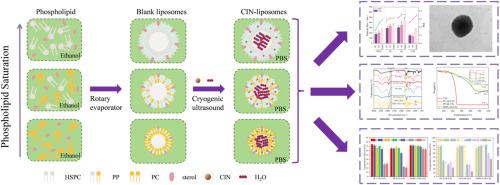Effects of phospholipid saturation on cinnamaldehyde liposomes: Structural insights, storage stability, and antioxidant properties
IF 5.8
2区 农林科学
Q1 ENGINEERING, CHEMICAL
引用次数: 0
Abstract
The impact of phospholipid saturation on the structure and stability of cinnamaldehyde liposomes was studied under different sterol conditions. This study prepared liposomes encapsulated for cinnamaldehyde (CIN-Lips) with phosphatidylcholine (PC), mixed phospholipids (PP, 50 % PC and 50 % HSPC), and hydrogenated soybean phosphatidylcholine (HSPC). The results of TEM, FTIR and Raman suggested that HSPC with higher phospholipid saturation could form rigid and tighter packed bilayer than PC and PP. Fluorescent probe analysis indicated that HSPC decreased membrane surface hydrophobicity and bilayer micro-polarity. In addition, the thermal, storage and oxidative stability of CIN-lips formed by PC, PP, and HSPC were also studied by TGA, free radical scavenging experiments. HSPC-CIN-Lips exhibited less weight loss than their high unsaturation counterparts. Under various sterol conditions, HSPC-CIN-Lips maintained significantly higher CIN retention and stronger free radical scavenging capacity than PC-CIN-Lips and PP-CIN-Lips after 60-day storage at 4 °C and 25 °C. Consequently, the compact membrane structure formed by highly saturated phospholipids (HSPC) effectively retarded CIN release and oxidation. These findings provide theoretical guidance for optimizing liposomal delivery systems and expand the application potential of HSPC.

磷脂饱和度对肉桂醛脂质体的影响:结构见解、储存稳定性和抗氧化性能
在不同的甾醇条件下,研究了磷脂饱和度对肉桂醛脂质体结构和稳定性的影响。以磷脂酰胆碱(PC)、混合磷脂(PP、50% PC和50% HSPC)和氢化大豆磷脂酰胆碱(HSPC)为包封剂,制备了肉桂醛(CIN-Lips)脂质体。透射电镜(TEM)、红外光谱(FTIR)和拉曼光谱(Raman)分析结果表明,磷脂饱和度较高的HSPC比PC和PP形成刚性更强的双层结构,荧光探针分析表明HSPC降低了膜表面疏水性和双层微极性。此外,我们还通过TGA和自由基清除实验研究了PC、PP和HSPC形成的chin -lips的热稳定性、储存稳定性和氧化稳定性。HSPC-CIN-Lips比其高不饱和度的同类表现出更少的体重减轻。在不同的甾醇条件下,HSPC-CIN-Lips在4°C和25°C条件下保存60天后,保持了比PC-CIN-Lips和PP-CIN-Lips更高的CIN保留率和更强的自由基清除能力。因此,由高度饱和磷脂(HSPC)形成的致密膜结构有效地延缓了CIN的释放和氧化。这些发现为优化脂质体递送系统提供了理论指导,扩大了HSPC的应用潜力。
本文章由计算机程序翻译,如有差异,请以英文原文为准。
求助全文
约1分钟内获得全文
求助全文
来源期刊

Journal of Food Engineering
工程技术-工程:化工
CiteScore
11.80
自引率
5.50%
发文量
275
审稿时长
24 days
期刊介绍:
The journal publishes original research and review papers on any subject at the interface between food and engineering, particularly those of relevance to industry, including:
Engineering properties of foods, food physics and physical chemistry; processing, measurement, control, packaging, storage and distribution; engineering aspects of the design and production of novel foods and of food service and catering; design and operation of food processes, plant and equipment; economics of food engineering, including the economics of alternative processes.
Accounts of food engineering achievements are of particular value.
 求助内容:
求助内容: 应助结果提醒方式:
应助结果提醒方式:


